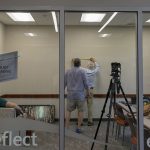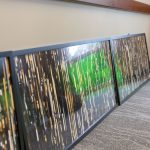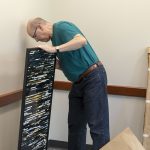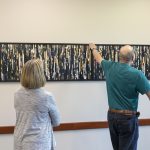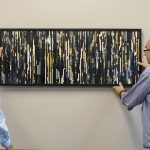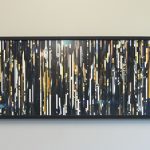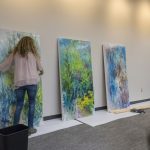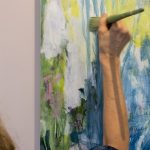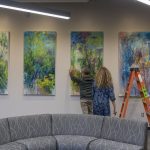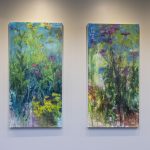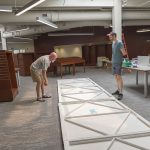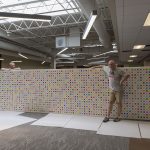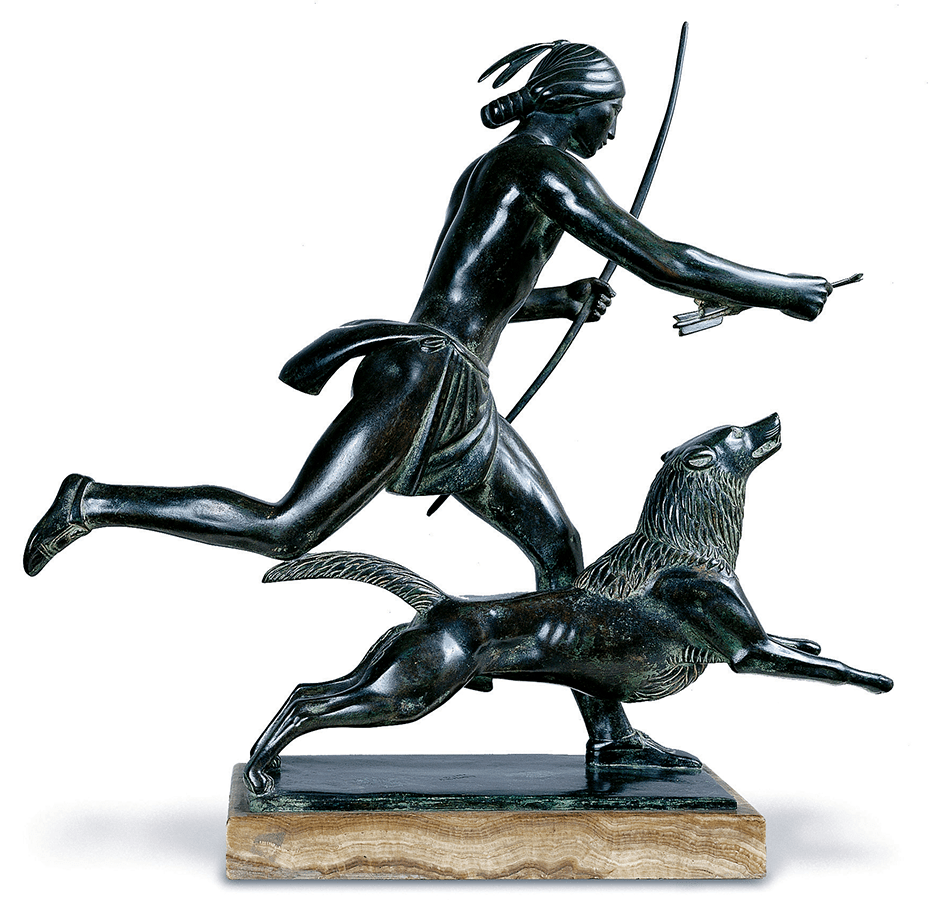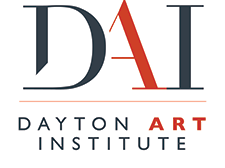West Carrollton
About the West Carrollton Art Installation and Artists
Ronald Geibert (b.1952) American, DIRECT OBSERVATION, 2017, archival pigment prints, Collection of the Dayton Metro Library, 2018.1
Beavercreek, Ohio photographer Ron Geibert, focuses his creative work on the examination, evaluation and understanding of language, images, text, and information—and how these impact learning and the way in which we draw conclusions. For this work, Geibert begins with the direct observation of the original artwork photographed in its’ museum setting from numerous viewpoints before he digitized and transformed it to share his reaction, memory, and impression of Manship’s work, Indian Hunter with his Dog.
About the Artist
Ron Geibert | A pioneer in the field of photography, Geibert introduced color photography into the fine arts program as a graduate student at he University of Nebraska-Lincoln. Later as a professor at Wright State University, Geibert’s interests led him to research a new field — multimedia — transforming his teaching and curatorial activities into CD-ROM publications of photography exhibitions and his creative work into sculptural electronic kiosks. Photographs by retired Wright State professor emeritus Ron Geibert can be found in significant collections including the MoMA (NYC), the Corcoran, the Library of Congress, and Smithsonian (Washington, D.C.), the Bibliothèque Nationale (Paris), and the Tokyo Metropolitan Museum of Photography among others.
You can find more information about this artist here, opens a new window..
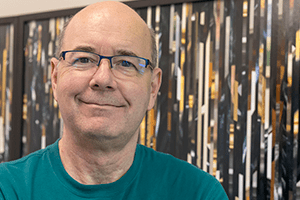
Jennifer Rosengarten (born 1965) American, THE FOUR SEASONS OF THE PRAIRIE, 2018, oil on panel, Collection of the Dayton Metro Library, 2018.3
Yellow Springs, Ohio artist Jennifer Rosengarten uses the natural world as inspiration for her large-scale paintings. Here she depicts the Ohio prairie in each of the four seasons, celebrating the diversity and beauty of the native prairie plants that once thrived in the West Carrollton area. Working in a visceral and intuitive process, Rosengarten reveals her interest in opposing tensions: energy and enervation, light and dark, the seen and unseen, the flatness of the surface and its counterpoint, deep illusionistic space. Rosengarten’s process evolves as a layering of experiences—perceived, remembered, and imagined through the expressive use of color and line.
About the Artist
JENNIFER ROSERGARTEN | As an undergraduate in Wright State University’s art department in the late 1980s, Rosengarten was instructed in observational representation, giving her a firm foundation to go on to get a master’s in fine art from Boston University and explore her personal artistic vision. Rosengarten and her husband moved to Yellow Springs 17 years ago to raise their son, Jack, here. Rosengarten describes her work as “on the fence between abstraction and representation,” and lists as her influences Cezanne, Matisse and Joan Mitchell, among others. Her paintings are clearly inspired by the natural world. Rosengarten’s work is represented in many private and public collections across the country. To learn more about this artist visit her website at www.jenniferrosengarten.com

Gary Hinsche (born 1944) American, INTERPRETIVE LANDSCAPE, 2018, acrylic on canvas, Collection of the Dayton Metro Library, 2018.2
Dayton artist, Gary Hinsche describes his art as ‘hard-edge” painting, a conceptually based form of minimalism. Focusing on a single idea Hinsche gives form and expression to that idea, making it tangible, and bringing it to life. His work is exacting, precisely planned and completely controlled. The perfect placement of objects in space demands the viewers attention and invites exploration and interaction. Interpretive Landscape defines and recognizes the colors of our landscape in random order the way they appear in nature. From a distance it’s just a field of color, however, a closer look offers a sense of movement and intrigue that invites us to pause and see.
About the Artist
GARY HINSCHE | Dayton artist, Gary Hinsche studied design at Santa Monica College, Long Beach State and Art Center College of Design before joining the legendary design firm of Robert Miles Runyan & Associates in 1968. Runyan had a profound influence on his life as a mentor, a partner and a friend for more than forty years. For Hinshce, the creative process is a reductive exercise that guides him to the simplest place. He constantly removes elements in search of the perfect relationship between the art and the viewer in order to control the experience. He is driven by the need to control everything. Every element is there for a purpose. Everything is precise. Doubt is the enemy. To learn more about this artist, please visit www.garyhinsche.com
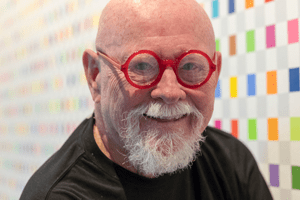
The Stories Behind the West Carrollton Art Inspiration
From the Collection of the Dayton Art Institute
Paul Manship (1885-1966) American, Indian Hunter with his Dog, 1926, Bronze with marble base, 23 ¾ x 23 x 8 ½ inches, The Dayton Art Institute, Bequest of the Honorable Jefferson Patterson, 1979.96
One of Paul Manship’s most popular bronzes, this is a scale reduction of an outdoor sculpture located in Manship’s hometown, St. Paul, Minnesota. Manship’s interest in naturalism is evident, the simplification of detail and sleek highly polished surface lend an abstract quality to the piece. Manship’s work can be seen as bridging the gap between tradition and modernism. While his subjects were drawn from traditional sources such as classical mythology, his streamlined forms reflected a modern outlook.
Rationale for inclusion: This newly remodeled library can be seen as a bridge between the traditional library and the 21st century library; one that incorporates elements essential to the new century, access, technology and community spaces. This work also evokes the former strong Native American presence in this area and the earthworks discovered in West Carrollton.
View this artwork and learn more by clicking here, opens a new window or visit The Dayton Art Institute.
Willard Leroy Metcalf (1858 – 1925) American, Valley in Spring, 1920, Oil on canvas, 35 7/8 x 36 inches, The Dayton Art Institute, Gift of Mr. John B. Hayward, 1929.3
The pastel palette, feathery brushwork and soft light are characteristic of Willard Metcalf’s impressionistic paintings. This painting’s tranquil mood and delicate, airy landscape make it easy to understand why Metcalf was called the “poet laureate” of New England.
Rationale for inclusion: Grassy lands for farming along the Great Miami River attracted the early settlers to West Carrollton. This painting complements the park-like setting of the West Carrollton library.

How did these pieces inspired our artists?
“Standing in front of Valley in Spring, I was completely drawn into its atmospheric vista and contemplative mood. Through life-size depiction of plant forms and the large scale of my paintings, I hope to encourage the same kind of immersive experience for the viewer that Valley in Spring creates.” Jennifer Rosengarten, artist
“I particularly respond to Metcalf’s ability to bring the seasons, the landscape to life – the way the viewer wants to see it and remember it, not necessarily reality…better than reality.” Gary Hinsche, artist
Directly observing Indian Hunter with his Dog in the museum from multiple perspectives inspired this digital work which explores the difference between direct and digital observations. In one significant way the impressions that one arrives at through direct observation are one’s own and not the result of algorithms, marketing tricks, or the “likes” by the anonymous.” Ron Geibert, artist
Thank you to our partner,
the Dayton Art Institute, opens a new window.
Photos of ReImagining Works pieces taken by Andy Snow.

